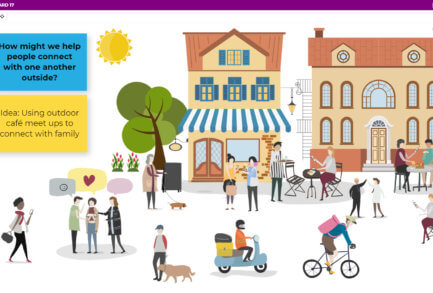How to engage extreme users in your design thinking project
Design thinking is all about developing a deep understanding of what the people you’re designing for think, want and need, so that you can then design solutions that will really work for them.
If you only look at your average users, you will only find average needs. But by looking at your extreme users, you’ll gain fresh insights you may not otherwise have heard. Extreme users are people on the margins of the challenge you’re exploring, with a unique perspective that can help you uncover solutions you would never have considered without them.
For example, if you’re designing for your employee team, your extreme users might be people who have just joined the business, people who have been there for years, or people in teams with a high turnover. Or if you’re designing for customers, you might want to speak with people who have recently moved away from your brand in favour of another, or to everyday and occasional users.
Did you know that there is a range of templates built into Sprintbase to help you get the best results from every stage of your innovation project? Not only that but each comes with clear instructions on how to use them, too.
Here’s how you can identify novel insights by speaking to extreme users – and how Sprintbase can help you do it.
How to do it
- Using the ‘Extreme Users’ template on Sprintbase, write down as many extreme ranges of behavior, preference or ability you can think of that relate to the challenge you’re trying to solve. Ranges to consider include age, experience, regularity of use, emotions e.g. love/hate, happy/sad, excited/bored etc.
- In step two of the template, capture the ranges you would most like to explore and try to identify specific user groups you’d like to speak to.
- Focusing on the groups you’ve come up with, think about which real people you can access. Where possible, add specific names of people you could talk to, and note down what you’d like to learn from them.
- It will also be helpful to plan how you will engage with these people – i.e. will you observe them or interview them? You can use the ‘Interview Planner’, ‘Shadowing’ or ‘Fly-on-the-wall’ templates to help you plan this.
Top tips from the experts:
- To help you be specific about which users you want to speak to, make sure you focus on a specific element of your design challenge you’d like to learn more about.
- Where possible, observe people in a context which relates to your challenge. For example, visit them where they work, live, shop or socialize. This enables you to see how they really behave and can lead to surprising insights.
- Applying this approach in your day-to-day work will also help you find out of the box solutions to everyday challenges. For example, you could use this template to help you think about how different groups might engage with a marketing campaign you’re producing, or a page on your website.
Extreme users are such an important part of empathy gathering because they help you see your challenge from entirely different perspectives, and spark truly innovative new ideas.
Good luck!
Start your free trial on Sprintbase today and see how the platform can help you achieve incredible results with design thinking.
More from the blog

How to stay creative while working remotely
The Sprintbase team – who have all been working remotely for years – share some of their tips for staying creative whilst working remotely.

How to write a design thinking project brief
There’s a lot of excitement at the start of a design thinking project. You’ve got a problem that needs solving, you’ve got people ready to help you tackle it, now you just want to get…

How to create beautiful prototypes remotely
We’ve revolutionized our whiteboards on Sprintbase, so that anybody – whether you’re creative or not – can produce beautiful, illustrated prototypes in minutes.
Get a free trial
Contact us to get your free trial or to talk about how Sprintbase can help you achieve your remote innovation goals.
Get started





